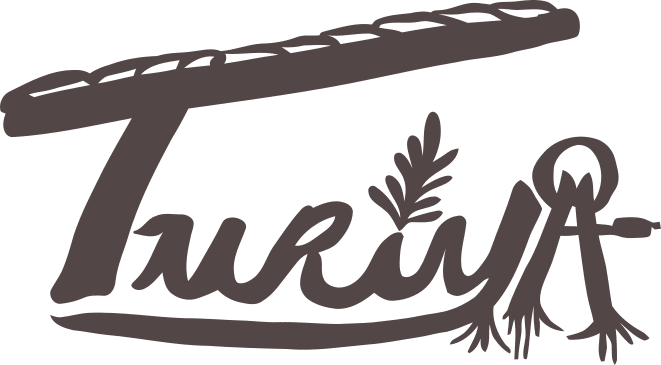How We Built our Mud Home in One Day
Unexpectedly, a series of events and visions led us to cut our nomadic travels short. When we left the US with one backpack each, we also left our comforts, our possessions, and our idea of what we thought a “successful” life was. I had the secure 9-to-5 job with a padded salary. I went to the highest peaks of education with my studies at Harvard and MIT. But none of it mattered. I did not feel that I identified with any of it. Everything that I had been told was of value in life – a college education, a well-paying job, a house in the suburbs – did not attract me as much as it used to. Aren’t these all human-made concepts? Do these really capture the essence of life? The decision was made. We were leaving, for somewhere, for something.

So, we left the US with our heavy travel gear (still holding on to things that we did not really need and which we eventually donated). While some might call it compulsive, it was the most natural decision I’d ever made, where my thought was distant, and my heart was fully present. We climbed the Himalaya mountains (one small heart-wrenching step at a time), spent months living disconnected in an Indian ashram, and then, somehow, landed in Panama.
With what could only be described as divine guidance, a week after we arrived in Panama, we found and bought our dream land in the mountain rainforest. We rented an apartment nearby, thinking of our next move: what kind of house do we build? What do we do with this land? As for what happened next, if I could describe anything as “the most magical experience of my life,” this would be it.
Meeting Chico - The Last Casa de Quincha Builder

The timing of what happened in the next few weeks seemed surreal. We met a man who lived only a few houses down from our apartment. He is a humble man named Chico, of about 5 feet in height, with worn-out leather sandals, sun-reddened skin, and a big belly peeking out the lower half of his partially-unbuttoned shirt. He was sitting in a house that he built himself, made of clay, sand, and straw, with aged clay tiles on the roof. In Panama, these are called “Quincha houses,” or you might hear of them as Casas de Quincha, casas de barro, or cob houses. We had come to find out that he is the last builder left of these traditional homes. After speaking with him very briefly (as he is a man of very few words), we agreed right then that we would love to have him help build our home.
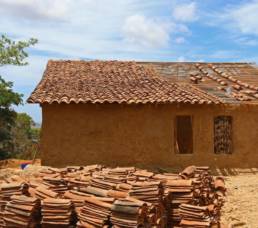
A Casa de Quincha is a type of cob structure, which are made of clay, sand, and straw and are common traditional buildings in tropical and desert climates around the world. This is for several reasons.
– They last for hundreds of years. There is a Casa de Quincha nearby out farm in Panama that is over 200 years old, and the oldest cob structure is 10,000 years old!
– They are fireproof, termite-proof, and earthquake-proof!
– They naturally regulate the temperature. Regardless of the outside temperature, the inside is always a perfect 68 to 70 degrees Fahrenheit. The walls expel and hold moisture and heat as needed, unlike the common concrete structures today, so you do not need A/C!
– They naturally circulate air through the cracks of the clay tiles in the roof. The home is not sealed off from the outside world like modern homes with insulation, sealants, etc. The home is able to breathe and equalize with the outer environment.
– They only require local materials: sand, clay, straw, and water, and that’s it! This makes them very affordable and much better for the environment. These natural materials are also very beneficial for health (I’ll add more on this later).
Panamanian Quincha Houses, or Casas de Quincha (cob houses), have a unique style. They typically have a front porch, with two or three large doors opening up to a main living space. Each door has a “traigaluz,” or a skylight, above them, and they often come in intricate designs. The main living space has a triangle roof and long beams that extend across called “cadenas.” The back half of the house can be divided into two or more rooms, based on preference.
How A Casa de Quincha (Panamanian Cob House) is Built
Step 1: Make the Wooden Frame (El Esqueleto)
The first part of the building process was collecting all of the wood. We found a local “wood guy” who got us what we needed. Certain woods like teak, mahogany, corotu, and cedar are naturally termite resistant. However, the termites can work their way through over time. The Panamanian people have great knowledge on how to properly choose wood for a long-lasting home. They cut wood during the menguante period, which is the period between the new moon and full moon. It has to do with a reduced water content in the wood which makes it very strong if cut during this one week period! If you want to use wood in a tropical climate, working with someone with experience is a must!
With all of the wood cut, Chico got to work, piece by piece, assembling the wooden skeleton (el esqueleto) of the house. After 5 months, our frame was ready. It was the largest Casa de Quincha that Chico had done, and it was the only one he ever did with gringos (foreigners).
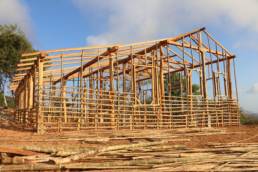
Step 2: Make the Cage (La Jaula) for the Casa de Quincha
Now, we needed to make a bamboo cage that would create the wall structure. This is where all of the mud/straw/sand mixtures will be piled. The cage of bamboo is created around the skeleton and all tied together with a special tree vine called “bejuco.” Both the bamboo and the vines are also cut during the menguante to ensure strength. Only the green bamboo can be used in these types of homes. Over 180 tall bamboo stalks were split and tied to create the walls of our home.

Step 3: Invite the Locals to your Junta de Embarra
In Spanish, “Junta” means “together.” In Panama, building a Casa de Quincha has always been a huge celebration. The community comes together to stomp the mud mixture for the house with their feet. Once the mud (el barro) is ready, they begin to stack the piles on both sides of the bamboo cage, slowly creating a thick cob wall. All the while, there is Panamanian liquor, music, coffee, chicha, and country spirit flowing.

We knew this was going to be a big event. It was the biggest Quincha House ever built in this area, perhaps all of Panama, and we needed our community’s help! So first, we had to set the date and get the word out. Only, we live deep in the countryside of Panama. There are no Facebook invites possible or even mailing addresses! The only way to do it is to go door-to-door, introducing yourself, and inviting the neighbors to your grand junta. A junta is a neighborly offering of friendship, and it is unspoken that you will then be ready to help your invitees build their homes when the time comes. Our 100-person small-town representative, who is also a good friend of ours, was kind enough to go with us on our 5-day invitation spree. He took us into every nook in the mountains where the best quincha house builders were living secluded on their farms.
Each family, without fail, welcomed us into their home and invited us to chat over coffee and bread, or even some fresh guarapo, or sugar cane juice. Many of them were in their 70s, and they grew up never seeing any structure but a Casa de Quincha. Now, with the rise of concrete production, this tradition is being lost, along with the skill of how to properly proportion the clay, sand, straw, and water. During these visits, the eyes of every person that I met lit up with nostalgia and joy when they heard we were continuing this beautiful tradition. For us, it is not just a house-build project. It is about keeping the timeless traditions and culture of the Panamanian people alive as the country moves towards modernization. It filled my heart to see how excited the locals were that a foreigner, typically an image of modernization, was about to build a home of the past.
Step 4: Gather the Food and Equipment to Feed 600 People
In a Junta de Embarra, the community comes to build your mud home. You provide the drinks, breakfast, lunch, and dinner (along with the materials to build). We wanted to honor the traditions and offer Comida Tipica (the typical Panamanian Junta food). This included coffee, carne asada, and bollo (pronounced BOY-yoh) for breakfast. Bollos are the Panamanian version of tamales. Our kind neighbor donated 2 fifty pound bags of freshly-harvested corn from his farm. This corn is cooked for at least 6 hours over a fire and then ground by a hand machine to make the corn masa. This masa is then steamed inside of corn husks to make the bollos.

We went to many vegetable markets around our village to complete the menu: sancocho soup and rice for lunch and rice with beef stew for dinner. We bought over 100 pounds of yuca, 10 pounds of carrots, 5 pounds of onions, 10 pounds of peppers, and so many other ingredients, including local seasonings like achiote seed. Another neighbor of ours named Rosa volunteered to lead the ladies (about 30 of them) in the outdoor cooking area during the junta. She told me exactly what I needed to feed everyone and to make the food especially-delicious.

Besides the food, every junta must have a special drink called chicha. Chicha is a drink made from toasted, blended corn, sweetened with natural sugar cane syrup (miel de caña) and flavored with cinnamon and ginger. Traditionally, Panamanian chicha also contains a special fruit called mamón, which adds a unique flavor. This chicha takes two days to prepare! I was able to buy the sugar cane from a man making it the traditional way using literal “horse power” via a trapiche. In a Panama trapiche, a horse is connected to a center axle. As the horse walks around in a large circle, he turns the axle and grinder, which squeezes out the juice from the sugar cane as the stalks are pushed through by a worker. The sugar cane juice (guarapo) is then boiled for hours. What you are left with is pure sugar cane crystals and syrup!
Day of the Junta for our Casa de Quincha
The locals began to trickle in around 7:00 am. The women had already been cooking the night before. The new arrivals were met with their traditional breakfast and Panamanian coffee. After that, the mixing began! The clay/sand mixture, which was already in the right proportion (we met a local reporter who studied where the best clay/sand mixtures were for quincha houses), was spread over a wide area using shovels. And then the water, from two 5000 Gallon water trucks, was poured over. Then the people lined up, arm-in-arm, and began stomping the mud with their feet. This helps to mix everything together. The lines of locals criss-crossed over the earthen soup, shouting the Panamanian country yodel to keep everyone motivated. Bottles of seco, local liquor, were passed around (this is also a MUST in a junta for building a Casa de Quincha. The workers expect seco, and with every drop, they worked even harder, if you can imagine!).

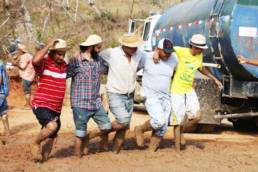
Next, bales of hay were spread by hand over the mixture, which was then stomped again. When the texture of the mud is firm enough to grab, the men get together in pairs, with arms linked, and slam their feet into the mud to cut a perfect pile to grab. Children from 4 years old and upward waited behind the men to grab a pile and toss to an adult waiting at the wall. Then the walls grew, layer by layer.

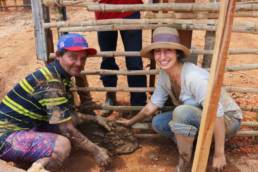
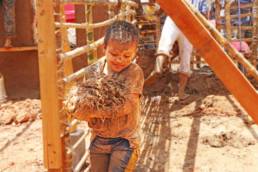

I got so many muddy hugs that day, and so many appreciative smiles -from parents sharing their tradition with their children, many of whom have never seen a junta, to older folk who were traveling back into their sweetest memories. I may be a foreigner, but the locals reminded us: “You are Panameños now!” The welcoming love blended our cultures together, and what I was witnessing was just humanity at its heart. Throughout the Casa de Quincha build, several music circles sprung up, with men drumming on leather-wrapped drums and women singing the songs of the countryside. If you can imagine the sweetest childlike joy, of people dancing, building, and then slipping in the mud, then you can envision the energy of the junta with 600 people doing this exact same thing.

The lunch was brought from my neighbors’ farm, where the fire pits were, up to our home, where it was served out of the back of a cattle truck. Everyone lined up and got their generous serving of rice and sancocho to replenish their energies. We built until 5pm that day, and we closed the day with a dinner cooked over fire and plenty of dancing under the mango trees.
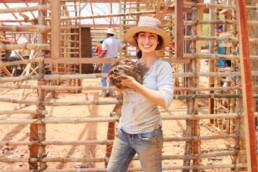
After the Junta de Embarra
In the weeks that followed, we laid the wood tiras (slats) on the roof, built out the traditional wrap-around porch, and laid each clay tile, over 5000 in number, by hand. These clay tiles came from a 150-year-old Casa de Quincha that was being torn down in nearby Sabana Grande. Each tile is different because they are made by forming a clay, horse dung, and sand compound to the upper thigh and then baking at a high temperature. So depending on a person’s leg, each clay tile will be different! A lot of work is left on our beautiful, traditional quincha house, but it is work that we do with love and immense gratitude.
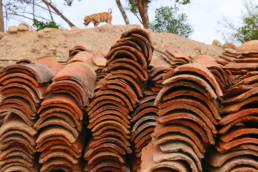
Healing Benefits of a Cob Casa de Quincha
A mud home is a house that breathes, that does not separate us from our environment. In modern homes, we use so much plastic, fiberglass, foam, chemical sealants and plastics, chemically-treated wood, and other unnatural material. For years afterwards, these materials release chemical emissions as well as entrap heat, forcing us to use electrical air conditioning to make up for the imbalance. We use chemical cleaning products, detergents, and food storage, and even the beds we sleep on are typically made from pesticide-laced fabrics.
All of this takes us away from our natural environment and forces your body to function within a synthetic space. There are so many more imbalances within the subtle tissues in the last 30 years, specifically with autoimmunity, diabetes, hormones, and the thyroid. Surrounding ourselves with a synthetic environment and separating ourselves further from nature, whether it be with our living spaces or our food, are taking away our precious health.
Wherever you can, take a step back, and trade in the “new” for the traditional, what is “excess” for the essential. Let your body and mind breathe by tapping into simplicity. Your health is your birthright. Nature is here to work with you, support you, and nourish your physical and spiritual growth, so that you can contribute your best, just like every other creature on the planet. If we can work with nature, and not against it, we will melt into the seamless joy and flow that comes with universal alignment.
Interested in donating to our future environmental, wellness, and ancient wisdom preservation projects?
